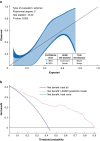Tailored risk assessment and forecasting in intermittent claudication
- PMID: 38411507
- PMCID: PMC10898330
- DOI: 10.1093/bjsopen/zrad166
Tailored risk assessment and forecasting in intermittent claudication
Abstract
Background: Guidelines recommend cardiovascular risk reduction and supervised exercise therapy as the first line of treatment in intermittent claudication, but implementation challenges and poor patient compliance lead to significant variation in management and therefore outcomes. The development of a precise risk stratification tool is proposed through a machine-learning algorithm that aims to provide personalized outcome predictions for different management strategies.
Methods: Feature selection was performed using the least absolute shrinkage and selection operator method. The model was developed using a bootstrapped sample based on patients with intermittent claudication from a vascular centre to predict chronic limb-threatening ischaemia, two or more revascularization procedures, major adverse cardiovascular events, and major adverse limb events. Algorithm performance was evaluated using the area under the receiver operating characteristic curve. Calibration curves were generated to assess the consistency between predicted and actual outcomes. Decision curve analysis was employed to evaluate the clinical utility. Validation was performed using a similar dataset.
Results: The bootstrapped sample of 10 000 patients was based on 255 patients. The model was validated using a similar sample of 254 patients. The area under the receiver operating characteristic curves for risk of progression to chronic limb-threatening ischaemia at 2 years (0.892), risk of progression to chronic limb-threatening ischaemia at 5 years (0.866), likelihood of major adverse cardiovascular events within 5 years (0.836), likelihood of major adverse limb events within 5 years (0.891), and likelihood of two or more revascularization procedures within 5 years (0.896) demonstrated excellent discrimination. Calibration curves demonstrated good consistency between predicted and actual outcomes and decision curve analysis confirmed clinical utility. Logistic regression yielded slightly lower area under the receiver operating characteristic curves for these outcomes compared with the least absolute shrinkage and selection operator algorithm (0.728, 0.717, 0.746, 0.756, and 0.733 respectively). External calibration curve and decision curve analysis confirmed the reliability and clinical utility of the model, surpassing traditional logistic regression.
Conclusion: The machine-learning algorithm successfully predicts outcomes for patients with intermittent claudication across various initial treatment strategies, offering potential for improved risk stratification and patient outcomes.
© The Author(s) 2024. Published by Oxford University Press on behalf of BJS Foundation Ltd.
Figures


References
-
- Fowkes FGR, Rudan D, Rudan I, Aboyans V, Denenberg JO, McDermott MM et al. Comparison of global estimates of prevalence and risk factors for peripheral artery disease in 2000 and 2010: a systematic review and analysis. Lancet 2013;382:1329–1340 - PubMed
-
- Golomb BA, Dang TT, Criqui MH. Peripheral arterial disease: morbidity and mortality implications. Circulation 2006;114:688–699 - PubMed
-
- Aboyans V, Ricco JB, Bartelink MLEL, Björck M, Brodmann M, Cohnert T et al. 2017 ESC Guidelines on the Diagnosis and Treatment of Peripheral Arterial Diseases, in collaboration with the European Society for Vascular Surgery (ESVS). Document covering atherosclerotic disease of extracranial carotid and vertebral, mesenteric, renal, upper and lower extremity arteries. Endorsed by: the European Stroke Organization (ESO). The Task Force for the Diagnosis and Treatment of Peripheral Arterial Diseases of the European Society of Cardiology (ESC) and of the European Society for Vascular Surgery (ESVS). Eur Heart J 2018;39:763–816 - PubMed
-
- National Institute for Health and Care Excellence . Peripheral Arterial Disease: Diagnosis and Management, Overview, Guidance. https://www.nice.org.uk/guidance/cg147 (accessed 7 May 2022) - PubMed
MeSH terms
LinkOut - more resources
Full Text Sources

